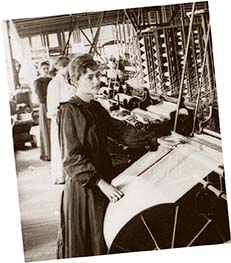SECTION 1: The New South

▲ Workers in a Mississippi textile mill
WITNESS HISTORY  AUDIO
AUDIO
Creating a “New South”
After the Civil War, forward-looking southern businessmen sought ways to diversify the southern economy and develop more industry. Henry Grady, editor of an Atlanta newspaper, described his vision of a “New South”:
“There was a South of slavery and secession— that South is dead. There is a South of union and freedom—that South, thank God, is living, breathing, growing every hour…. The old South rested everything on slavery and agriculture, unconscious that these could neither give nor maintain healthy growth. The new South presents a perfect democracy, … a social system compact and closely knitted, less splendid on the surface, but stronger at the core … and a diversified industry that meets the complex needs of this complex age.”
—Henry Grady, 1886
Objectives
- Explain how the southern economy changed in the late 1800s.
- Analyze how southern farmers consolidated their political power.
- Describe the experience of African Americans in the changing South.
Terms and People
- cash crop
- Farmers’ Alliance
- Civil Rights Act of 1875
NoteTaking
Reading Skill: Identify Supporting Details As you read, fill in a concept web like the one below with details about how the South changed after the Civil War. Add additional circles as needed.

Why It Matters After Reconstruction ended, the South struggled to develop its industry. Although there were pockets of success, the South was not able to overcome its economic and social obstacles to industrial development overall. As a result, the South remained largely agricultural and poor. Section Focus Question: How did the southern economy and society change after the Civil War?
Industries and Cities Grow
During the Gilded Age, many southern white leaders envisioned a modernized economy that included not only agriculture but also mills and factories. Henry Grady was among those who called for a “New South” that would use its resources to develop industry.
New Industries Spread Through the South
Before the Civil War, the South had shipped its raw materials—including cotton, wood, and iron ore—abroad or to the North for processing into finished goods. In the 1880s, northern money backed textile factories in western North Carolina, South Carolina, and Georgia, as well as cigar and lumber production, especially in North Carolina and Virginia. Investment in coal-, iron-, and steel-processing created urban centers in Nashville, Tennessee, and Birmingham, Alabama.
During this time, farming also became somewhat more diversified, with an increase in grain, tobacco, and fruit crops. Even the landscape of farming changed as smaller farms replaced large plantations.




